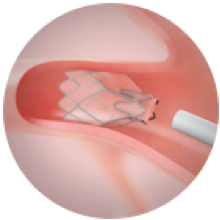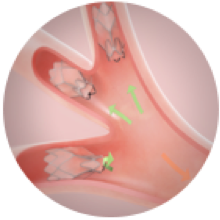
A one-way valve is deployed within an airway, which allows air out but not back into the upstream segment. This helps to reduce the volume of the lung.

Several valves are deployed within one lobe of the lung.

The second method is to introduce a number of coils which restore some of the natural springiness to the lung, helping to prevent over-expansion. In this subject coils have been inserted into the upper lobes of both lungs, which have the effect of reducing their volume)
By whichever method, removal of this excessive lung volume improves thoracic mechanics and relieves the sensation of breathlessness. Although these procedures carry a small risk, lung volume reduction is one of the few treatments which has the potential to extend life expectancy in those with severe COPD.
Selection of patients for lung volume reduction depends upon the findings from various investigations including a CT scan and full lung function testing in our lab. After careful discussion of the pros and cons we can then refer those people who may benefit to a surgical centre for consideration and further tests.
If you have COPD and would like to discuss any of the above possible treatments or anything else, please contact us for an appointment at which we can discuss all aspects of your respiratory health and the details of the programme. You can email info@guildfordrespiratory.co.uk or call on 01483 555800 ext 5297 or 07495 261 587.

